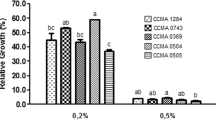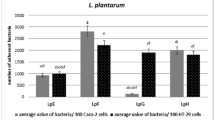Abstract
The aim of this research was to determine the potential probiotic activity of Lactobacillus acidophilus ATCC 4356 against several human Campylobacter jejuni isolates. The ability to inhibit the pathogen’s growth was evaluated by co-culture experiments as well as by antimicrobial assays with cell-free culture supernatant (CFCS), while interference with adhesion/invasion to intestinal Caco-2 cells was studied by exclusion, competition, and displacement tests. In the co-culture experiments L. acidophilus ATCC 4356 strain reduced the growth of C. jejuni with variable percentages of inhibition related to the contact time. The CFCS showed inhibitory activity against C. jejuni strains, stability to low pH, and thermal treatment and sensitivity to proteinase K and trypsin. L. acidophilus ATCC 4356 was able to reduce the adhesion and invasion to Caco-2 cells by most of the human C. jejuni strains. Displacement and exclusion mechanisms seem to be the preferred modalities, which caused a significant reduction of adhesion/invasion of pathogens to intestinal cells. The observed inhibitory properties of L. acidophilus ATCC 4356 on growth ability and on cells adhesion/invasion of C. jejuni may offer potential use of this strain for the management of Campylobacter infections.
Similar content being viewed by others
References
Alander M, Satokari R, Korpela R, Saxelin M, Vilpponen-Salmela T, Mattila-Sandholm T, vonWright A (1999) Persistence of colonization of human colonic mucosa by a probiotic strain, Lactobacillus rhamnosus GG, after oral consumption. Appl Environ Microbiol 65:351–354
Avall-Jaaskelainen S, Palva A (2005) Lactobacillus surface layers and their applications. FEMS Microbiol Rev 29:511–529
Boyanova L, Gergova G, Spassova Z, Koumanova R, Yaneva P, Mitov I, Derejian S, Krastev Z (2004) Campylobacter infection in 682 Bulgarian patients with acute enterocolitis, inflammatory bowel disease, and other chronic intestinal diseases. Diagn Microbiol Infect Dis 49:71–74
Campana R, Patrone V, Federici S, Fulvi S, Baffone W (2010) Antibiotic resistance of Campylobacter spp. isolated from chickens and humans in central Italy. J Food Saf 30:924–940
Candela M, Perna F, Carnevali P, Vitali B, Ciati R, Gionchetti P, Rizzello F, Campieri M, Brigidi P (2008) Interaction of probiotic Lactobacillus and Bifidobacterium strains with human intestinal epithelial cells: adhesion properties, competition against enteropathogens and modulation of IL-8 production. Int J Food Microbiol 125:286–292
Chaveerach P, Lipman LJA, van Knapen F (2004) Antagonistic activities of several bacteria on in vitro growth of 10 strains of Campylobacter jejuni/coli. Int J Food Microbiol 90:43–50
Chen X, Xu J, Shuai J, Chen J, Zhang Z, Fang W (2007) The S-layer proteins of Lactobacillus crispatus strain ZJ001 is responsible for competitive exclusion against Escherichia coli O157:H7 and Salmonella typhimurium. Int J Food Microbiol 115:307–315
Collado MC, Gueimonde M, Hernandez M, Sanz Y, Salminen S (2005) Adhesion of selected Bifidobacterium strains to human intestinal mucus and its role in enteropathogen exclusion. J Food Protect 68:2672–2678
Delgado S, Florez AB, Mayo B (2005) Antibiotic susceptibility of Lactobacillus and Bifidobacterium species from the human gastrointestinal tract. Curr Microbiol 50:202–207
Dong H, Rowland I, Tuohy KM, Thomas LV, Yaqoob P (2010) Selective effects of Lactobacillus casei Shirota on T cell activation, natural killer cell activity and cytokine production. Clin Exp Immunol 161:378–388
Eschenbach DA, Davick PR, Williams BL, Klebanoff SJ, Young-Smith K, Critchlow CM, Holmes KK (1989) Prevalence of hydrogen peroxide-producing Lactobacillus species in normal women and women with bacterial vaginosis. J Clin Microbiol 27:251–256
Food and Health Agricultural Organization (FHAO) of the United Nations and Word Health Organization (2002) Guidelines for the evaluation of probiotics in food. Working Group Rep. 2002. Food and Health Agricultural Organization of the United Nations and Word Health Organization, Washington
Forestier C, De Champs C, Vatoux C, Joly B (2001) Probiotic activities of Lactobacillus casei rhamnosus: in vitro adherence to intestinal cells and antimicrobial properties. Res Microbiol 152:167–173
Fujiwara S, Hashiba H, Hirota T, Forstner JF (1999) Purification and characterization of a novel protein produced by Bifidobacterium longum SBT2928 that inhibits the binding of enterotoxigenic Escherichia coli Pb176 (CFA/II) to gangliotetraosylceramide. J Appl Microbiol 86:615–621
Galdeano CM, de Leblanc AdeM, Carmuega E, Weill R, Perdigón G (2009) Mechanisms involved in the immunostimulation by probiotic fermented milk. J Dairy Res 76:446–454
Garcia Rodriguez LA, Ruigomez A, Panes J (2006) Acute gastroenteritis is followed by an increased risk of inflammatory bowel disease. Gastroenterology 130:1588–1594
Kalischuk LD, Inglis GD, Buret AG (2007) Strain-dependent induction of epithelial cell oncosis by Campylobacter jejuni is correlated with invasion ability and is independent of cytolethal distending toxin. Microbiology 153:2952–2963
Klein M, Sanders ME, Duong T, Young HA (2010) Probiotics: from bench to market. Ann NY Acad Sci 1212(Suppl 1):E1–14
Kos B, Suskovic J, Vukovic S, Simpraga M, Frece J, Matosic S (2003) Adhesion and aggregation ability of probiotic strain Lactobacillus acidophilus M92. J Appl Microbiol 94:981–987
Jakava-Viljanen M, Palva A (2007) Isolation of surface (S) layer protein carrying Lactobacillus species from porcine intestine and faeces and characterization of their adhesion properties to different host tissues. Vet Microbiol 124:264–273
Lee YK, Puong KY (2002) Competition for adhesion between probiotics and human gastrointestinal pathogens in presence of carbohydrate. Brit J Nutr 88:101–108
Lee YK, Puong KY, Ouwehand AC, Salminen S (2003) Displacement of bacterial pathogens from mucus and Caco-2 cell surface by lactobacilli. J Med Microbiol 52:925–930
Lehtopolku M, Nakari UM, Kotilainen P, Huovinen P, Siitonen A, Hakanen AJ (2010) Antimicrobial susceptibilities of multidrug-resistant Campylobacter jejuni and C. coli strains: in vitro activities of 20 antimicrobial agents. Antimicrob Agents Chemother 50:1232–1236
Lievin V, Peiffer I, Hudault S, Rochat F, Brassart D, Neeser JR, Servin AL (2000) Bifidobacterium strains from resident infant human gastrointestinal microflora exert antimicrobial activity. Gut 47:646–652
Marshall JK, Thabane M, Garg AX, Clark WF, Salvadori M, Collins SM (2006) Incidence and epidemiology of irritable bowel syndrome after a large waterborne outbreak of bacterial dysentery. Gastroenterology 131:445–450
Santini C, Baffoni L, Gaggia F, Granata M, Gasbarri R, Di Gioia D, Biavati B (2010) Characterization of probiotic strains: an application as feed additives in poultry against Campylobacter jejuni. Int J Food Microbiol 141:S98–S108
Searle LE, Best A, Nunez A, Salguero FJ, Johnson L, Weyer U, Dugdale AH, Cooley WA, Carter B, Jones G, Tzortzis G, Woodward MJ, La Ragione RM (2009) A mixture containing galactooligosaccharide, produced by the enzymic activity of Bifidobacterium bifidum, reduces Salmonella enterica serovar Typhimurium infection in mice. J Med Microbiol 58:37–48
Servin AL (2004) Antagonistic activity of lactobacilli and bifidobacteria against microbial pathogens. FEMS Microbiol Rev 28:405–440
Sheehan VM, Sleator RD, Hill C, Fitzgerald GF (2007) Improving gastric transit, gastrointestinal persistence and therapeutic efficacy of the probiotic strain Bifidobacterium breve UCC2003. Microbiology 53:3563–3571
Sherman PM, Ossa JC, Johnson-Henry K (2009) Unravelling mechanisms of action of probiotics. Nutr Clin Pract 24:10–14
Sherman PM, Ossa JC, Wine E (2010) Bacterial infections: new and emerging enteric pathogens. Curr Opin Gastroenterol 26:1–4
Teneberg S, Angstrom J, Ljungh A (2004) Carbohydrate recognition by enterohemorrhagic Escherichia coli: characterization of a novel glycosphingolipid from cat small intestine. Glycobiology 14:187–196
Thakur S, Zhao S, McDermott PF, Harbottle H, Abbott J, English L, Gebreyes WA, White DG (2010) Antimicrobial resistance, virulence, and genotypic profile comparison of Campylobacter jejuni and Campylobacter coli isolated from humans and retail meats. Foodborne Pathog Dis 7:835–844
Ventura M, O’Flaherty S, Claesson MJ, Turroni F, Klaenhammer TR, van Sinderen D, O’Toole PW (2009) Genome-scale analyses of health-promoting bacteria: probiogenomics. Nat Rev Microbiol 7:61–71
Wine E, Gareau MG, Johnson-Henry K, Sherman PM (2009) Strain-specific probiotic (Lactobacillus helveticus) inhibition of Campylobacter jejuni invasion of human intestinal epithelial cells. FEMS Microbiol Lett 300:146–152
Yabe S, Higuchi W, Iwao Y, Takano T, Razvina O, Reva I, Nishiyama A, Yamamoto T (2010) Molecular typing of Campylobacter jejuni and C. coli from chickens and patients with gastritis or Guillain–Barré syndrome based on multilocus sequence types and pulsed-field gel electrophoresis patterns. Microbiol Immunol 54:362–367
Young KT, Davis LM, Di Rita VJ (2007) Campylobacter jejuni: molecular biology and pathogenesis. Nat Rev Microbiol 5:665–679
Zhang M, He L, Li Q, Sun H, Gu Y, You Y, Meng F, Zhang J (2010) Genomic characterization of the Guillain-Barré syndrome-associated Campylobacter jejuni ICDCCJ07001 isolate. PloS one 5:e15060
Author information
Authors and Affiliations
Corresponding author
Rights and permissions
About this article
Cite this article
Campana, R., Federici, S., Ciandrini, E. et al. Antagonistic Activity of Lactobacillus acidophilus ATCC 4356 on the Growth and Adhesion/Invasion Characteristics of Human Campylobacter jejuni . Curr Microbiol 64, 371–378 (2012). https://doi.org/10.1007/s00284-012-0080-0
Received:
Accepted:
Published:
Issue Date:
DOI: https://doi.org/10.1007/s00284-012-0080-0




